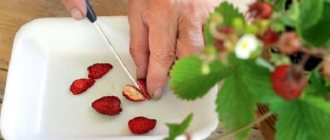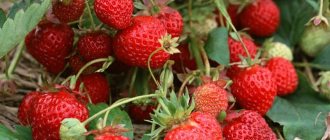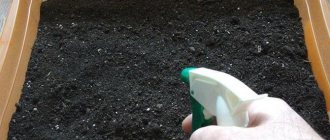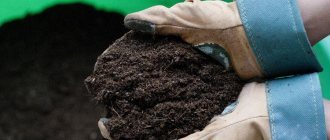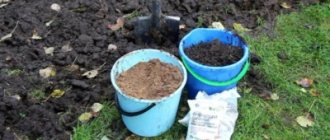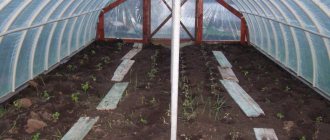Home / Garden / Berries
Back
Published: 07/05/2020
0
Rate this post
Garden strawberries, or strawberries as they are also called, are a very demanding plant. You can get a good harvest when growing in your summer cottage by following the basic rules. The plant is sensitive to the composition of the soil, so before planting you need to clarify what kind of soil the strawberries like.
Excessively acidic or alkaline soil is not suitable for this plant; it should be slightly acidic or neutral. To get a good harvest of berries, the area under the crop must be regularly disinfected and fertilized.
- 1 How to properly prepare the soil? 1.1 Suitable landing site
- 1.2 Soil disinfection
- 1.3 Soil fertilization
What kind of soil do strawberries like: acidic or alkaline?
The acidity of the soil will determine how well the crop will develop, whether it will be susceptible to diseases, and whether there is enough nutrition for full ripening.
Did you know? The most elaborate strawberry dessert, worth $1.4 million, is served in the USA, in a New Orleans restaurant. The highlight of the dessert is the pink diamond jewelry that comes with it.
A small comparison of indicators will help you determine which soils are preferable for strawberries:
- pH 3-4 is a strongly acidic soil, which has a negligible content of nitrogen, potassium, boron and phosphorus. And these are the substances that are necessary throughout the growing season. In such soil there is an increased content of aluminum, iron, and manganese. An excess of these minerals reduces the ability of root system cells to absorb already meager nutrition;
- pH 7-8 - slightly alkaline soil is characterized by a lack of phosphorus, but if it is constantly replenished with the help of fertilizing, then a lack of zinc and copper occurs, which leads to chlorosis;
- pH 8-9 - increased alkaline reaction is characterized by a lack of nitrogen and phosphorus, an excess of copper, manganese, zinc. This factor slows down the development of the plant and leads to curling of the foliage.
The conclusion suggests itself: for good development of strawberries, you need slightly acidic soil or with a neutral reaction. In slightly acidic soils, the amount of necessary elements is close to the ideal composition (in a neutral environment it is optimal); with the help of fertilizing, the crop receives everything it needs. In addition, the vital activity of beneficial microorganisms is best demonstrated in slightly acidic and neutral soil. Ideal acidity parameters for berries are in the range of 5.5–6.5 pH.
No less important is the structure of the soil for strawberries and its carrying capacity. Both loose sandstones and heavy clay soils are equally unsuitable. Nutritious chernozem, with proper feeding, for example, mulching with pine needles, will become an ideal soil. But such lands do not exist everywhere.
Suitable in composition, “correct soil” are the following lands:
- sandy loam — quickly evaporates moisture without forming a crust on the surface, perfectly allows air and water to pass deep, lightweight;
- loamy - quite fertile, perfectly transmits and retains moisture, loose, allows heat and air to pass through.
Choosing the right location
It is generally accepted that the most suitable areas are those that are abundantly illuminated by sunlight and without sudden gusts of drafts. The presence of tall and bulky deciduous trees will hinder the development of bushes due to the shadow falling on the plant.
For planting, it is better to choose flat areas without an obvious lowland, in which rainwater will collect and evaporate for a long time; the area may be slightly sloping.
Ideal groundwater indicators will be figures not exceeding 2 meters from the surface, otherwise the root system will be highly susceptible to rotting.
Preparing the soil for spring planting
A new, previously unused site is prepared in 1-2 years. Along with deep digging and cleaning of weeds, stones, large roots or branches, if necessary, the earth is deoxidized. To do this, it is best to add wood ash (hardwood) or dolomite flour, which is rich in magnesium.
Application rates, depending on the indicator, are 300–600 g of substance per square meter. Add sand to heavy soil, about 2 kg/m²; sandy soil is made heavier by adding chernozem and peat (up to 8 kg/m²).
Selecting a location
The area for planting strawberries should be protected from drafts and at the same time open to sunlight. Tall bushes and trees that cast a shadow on future planting are not desirable along the perimeter. The place should be flat, a slight slope is allowed, but not a lowland where melt and rainwater accumulates. The location of groundwater is below 2 m from the surface, which will preserve the root system from rotting.
Important! You cannot plant garden berries after garden crops such as vegetables from the nightshade family: they leave spores of many diseases in the soil.
Methods for soil disinfection
The soil, as it is used, tends to accumulate microorganisms, including those harmful to crops. Insects and their larvae often overwinter in it, so disinfecting the soil is one of the gardener’s primary tasks.
Chemical
Chemical preparations, for the most part, contain components harmful to strawberries, so they use the most gentle means.
Effective use of such means:
- TMTD (fungicide) is not dangerous for plants, so it can be used before planting. Destroys pathogens of root rot, late blight;
- Copper sulfate is used once every five years, since copper accumulates in the soil, and its excess negatively affects the development of plants. The product is effective against most fungal diseases;
- “Rovral” (fungicide) is safe for the plant, so it can be placed in the planting hole. Protects berry bushes from damage by various types of fungi.
Important! Along with pathogenic bacteria, beneficial microorganisms also die under the influence of aggressive chemicals, so after disinfection it is necessary to restore the fertility of the soil.
Biological
For safe disinfection, biological preparations are used that contain strains of bacteria that produce antibiotics that destroy pathogenic microorganisms. Therefore, they are used both for soil disinfection and for treating plants at any stage of development.
Among these drugs:
- "Alirin-B";
- "Baktofit";
- "Gamair";
- "Fitosporin-M".
Agrotechnical
In addition to the fact that the soil is manually cleared of plant residues during autumn digging, repellent plants to repel insects, which themselves are pests and carry pathogens.
The list of such plants is huge, the most famous of them:
- marigold;
- nasturtium;
- tansy;
- sagebrush;
- garlic.
Another method, quite lengthy, but effective and safe:
- The land on the site, which has been used for 3-5 years, is dug out in layers.
- Layers of soil are stacked and treated with slurry.
- For about 3–5 years, the soil rests with regular shoveling of the layers and removal of sprouted weeds.
- During this time, the spores of many diseases, such as rot (of various types), die in the soil, and the seeds of weed plants die.
Fertilizing the land before planting
In the spring, before planting plants, the area prepared in the fall is fertilized with a mixture of organic and mineral substances (per m²):
- humus - 6 kg;
- potassium sulfate - 120 g;
- superphosphate - 100 g.
After digging and adding food, the area is leveled and the beds are prepared. As the bushes grow, peat mulch is beneficial for strawberries.
How to increase fertility
The main rule that must be taken into account to increase crop productivity is crop rotation. Many plants radically deplete the soil, so it needs to rest. Others, in turn, improve its quality. These include cereals and legumes. It is worth practicing mixing plantings, planting crops of different families nearby.
Every year, during spring digging, organic matter is added under the bushes. Can be used:
- compost;
- chicken droppings;
- mullein;
- humus.
The compounds contained in organic fertilizers are sufficient to saturate the soil with the required mineral components. Vermicompost is used to restore fertility.
The soil cannot be used constantly; it must rest for some time. To restore quality, organic compounds are added to feed it. Cultivation of garden strawberries in the same area is possible for 2-3 years.
Tips for beginner gardeners
If the composition of the soil on your site leaves much to be desired, it is possible to “prepare” the soil with your own hands.
Sequencing:
- The top layer, 8–10 cm, is removed from forest podzolic soil.
- Several layers are folded into a pile measuring 100x80 cm.
- Before laying, each layer is moistened abundantly.
- The collar is tightly covered with film, making several holes in it for air access.
- Under a polyethylene shelter, the temperature rises, which leads to the “burning” of all microorganisms and plant debris in the soil.
- After 3 months, the composition of the earth layers in the pile becomes ideal for growing sweet and aromatic berries.
Did you know? The record weight of strawberries was recorded in 1983 in the USA. The weight of the berry grown by a local farmer was 231 g.
By properly preparing the soil for planting a crop, the gardener will receive an excellent harvest. We should not forget, however, about timely care of strawberries.
Disinfection options
Land that has been in use for a long time accumulates microorganisms from all previously grown crops, which are better to get rid of in the first stages of planting.
With such manipulations it will also be possible to destroy harmful insects with their larvae, which will be the key to successful and fruitful cultivation of berries. Experienced agronomists consider these actions to be the initial and most important in working with crops, therefore they pay a lot of attention to the process.
Drip irrigation
Drip irrigation system is a popular type of hydroponic setup. The essence of the method is that the nutrient solution is supplied from the container using electric pumps strictly on schedule directly to the roots of the plant. The substrate is evenly saturated with moisture, which is very useful for strawberries. There are two types of drip installations:
- reversible;
- irreversible.
In the first option, the nutrient solution is reused after watering. In the second, the solution is applied only once, and possible residues are disposed of or completely absorbed by the roots of the plant.
The drip irrigation system is simple and easy to use. You can buy it in the store. Those who want to experiment with hydroponics can build the installation themselves from available components. The simplest structure can be built from a PVC pipe in which glasses with seedlings are placed. The pipes are connected with elastic hoses, and plugs are installed on the sides. More details about such a system can be found in the article: “Homemade hydroponic installation. Drip irrigation system."
To avoid mold and mildew, the system must be cleaned regularly.
Benefits of growing strawberries from seeds
Many people think that growing strawberries from seeds is very difficult. But in fact it is quite possible. The main thing is that appropriate conditions are created. Then the sprouts will not die and they can be planted in the ground.
Do you have experience growing strawberries from seeds at home?
Not really
Advantages of growing berries from seeds:
- seed material is stored for a long time (unlike seedlings);
- you can choose any variety yourself;
- seeds are cheaper than good strawberry seedlings;
- when growing berries from seeds, the gardener knows exactly the characteristics of each variety;
- even one berry produces several dozen bushes.
Helpful information
Daria Vorontsova
Amateur gardener. He is interested in growing various greens at home.
It is recommended to purchase strawberry seed material in winter, since it is already difficult to find it on sale in the spring. It is better not to buy elite, expensive seeds if you have not previously had experience in growing berries this way. And be sure to check the expiration date.
Use of chemicals
Each of the auxiliary liquids has a rather bad effect on strawberries, so it would be advisable to use factory products sparingly. It is possible to make these components effective and not cause damage to the future harvest only if the proportions and method of implementation are correctly observed.
To destroy harmful pathogens of root rot, TMTD is used, which is known to many as a fungicide. This product can be used immediately before planting plants, as it is not too dangerous for them.
Copper sulfate has proven itself well, but it is used very rarely due to the accumulation of copper in the ground after its use.
Pay attention to the beds
When it comes to direct planting, you need to pay attention to the arrangement of the rows; they always begin to be formed in the direction from north to south. Thanks to such actions, all bushes, without exception, will receive uniform lighting throughout the entire light period of the day.
The distance between the beds is maintained up to 70 centimeters at the discretion of the owner, the bushes are planted 20-40 centimeters apart. All indicators are adjusted depending on the expected growth vigor and abundance of green mass.
If the plot is not too large in size, most agronomists come out of the situation as winners by forming tiered flower beds. Natural stone and old cinder block are used for construction, the idea is quite practical, and the appearance will help decorate the garden plot for the benefit of the whole family.
Biological compounds
Disinfecting measures can also be carried out using other preparations that contain strains of bacteria from antibiotics known to all people. Microorganisms cannot resist the influence of such protective agents on them, and plants are treated with solutions even in the first stages of life.
From the list of possible names used for treatment and disarming, the following can be distinguished: “Alirin-B” and “Baktofit”.
Features of the technology
Hydroponic modules can operate in a variety of conditions. Nutrition is supplied to the roots in various ways. Therefore, there are the following types of installations:
- Deep-water system: a platform with plants is immersed in a container of water;
- Nutrient layer system: under the pots with plants there is a substrate, regularly irrigated with a nutrient solution;
- Drip system: the nutrient solution saturates the substrate in portions, at time intervals;
- Flooding system: the substrate is filled with a large amount of solution, then the solution is removed;
- Aeroponics: Strawberry roots are kept in a moist environment in the form of mist, and this mist contains essential nutrients.
All methods allow you to get a strawberry harvest, but not all methods are ideal for strawberries. For example, the deep-water irrigation system has a significant flaw. The fact is that the roots of the plant do not tolerate excessive humidity well; it needs oxygen, and excess humidity contributes to the development of rot and mold.
Pros and cons of technology
Hydroponics, as a method of progressive crop production, has advantages and disadvantages. Growing strawberries hydroponically is a simple process. However, before you start breeding plants, you need to make an accurate calculation, calculate income and expenses, and assess possible risks. The advantages of the technology are worth noting:
- saving space;
- no need for daily watering;
- no dependence on weather conditions;
- resistance to fungi and pests;
- high productivity;
- rapid ripening of strawberries;
- environmental friendliness of the product.
In addition to the advantages, this technology has some disadvantages. In particular, it is worth noting such disadvantages as constant monitoring. Plants grown hydroponically require daily care. It is necessary to maintain the level of nutrition and its composition, the level of water consumption, substrate humidity and light conditions. Constant monitoring may seem tedious to a novice gardener. But the result justifies the effort, especially since all this can be done under the control of simple automation.
Microclimate
Strawberries develop and bear fruit successfully in warm climates. The room must maintain an optimal level of air temperature and humidity. Strawberries bloom and bear fruit at daytime temperatures of plus 24, night temperatures of at least 16 degrees Celsius. Optimal humidity is within 60-70%. Excessive humidity can lead to the development of fungus; dry air slows down plant growth.
It is necessary to constantly monitor the supply of nutrients, lighting, pollination and air temperature. If all the necessary conditions are met, harvesting is greatly simplified. In an ideal microclimate, plants reveal their potential. Fruits grown hydroponically are incredibly tasty and aromatic. Growing does not create any additional problems, because... there are no weeds or pests.
System Description
A hydroponic setup looks like this. This is a large container filled with a nutrient solution, saturated with useful substances. The liquid circulates inside the hydroponic system using pumps. Strawberry bushes are planted in glasses or pots filled with substrate. There are the following types of hydroponic systems:
- passive;
- active.
In the first case, no pumps or mechanical devices are used. These methods include wick systems or the nutrient layer method. You can learn more about the varieties of hydroponics in the article: “What is hydroponics.” In the second case, fluid circulation is ensured by the continuous operation of pumps.
